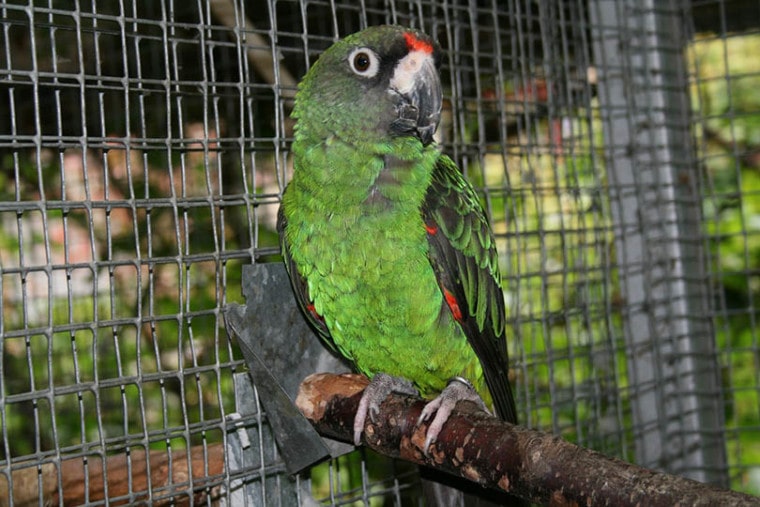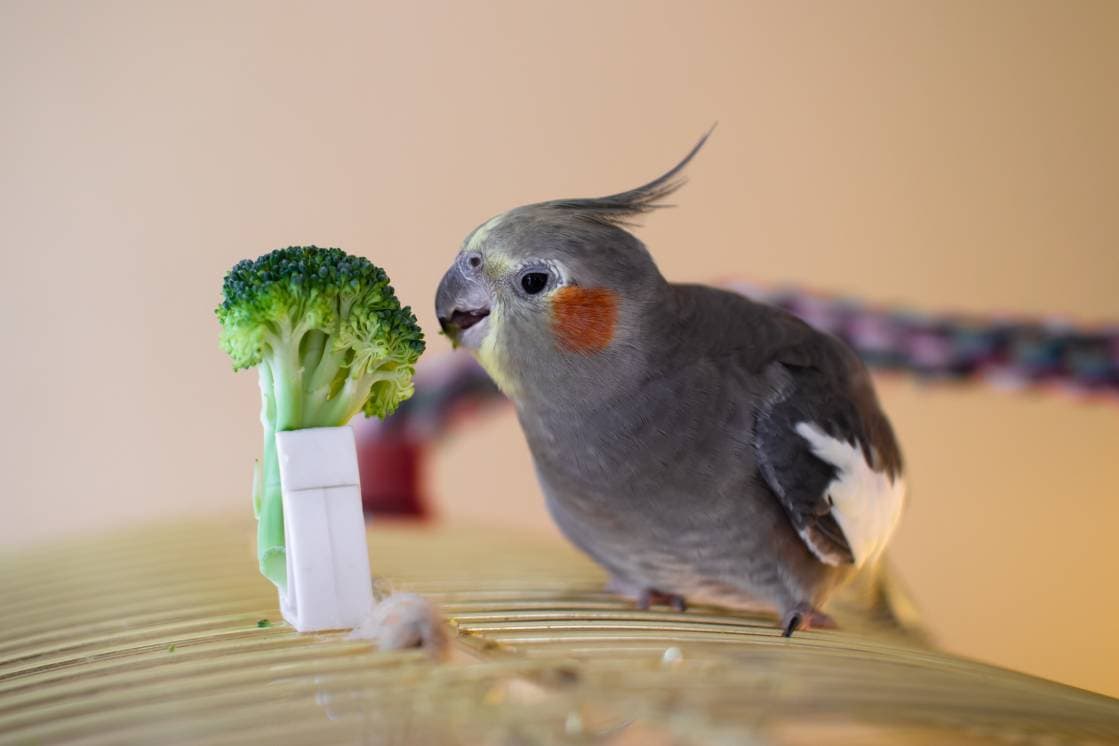
Known for its bright red and green feathering, the Jardine’s Parrot is a popular pet across the globe. The birds come in many variations determined by their native location in Africa and are beloved for their intelligent and playful personalities. This popularity has been a double-edged sword, leading to widespread trapping and trade of the birds and threatening their wild populations.
Species Overview
| Common Names: | Jardine’s Parrot, Red-Fronted Parrot, Red-Headed Parrot, Red-Crowned Parrot, Jardine Parrot, Congo Red-Crowned Parrot |
| Scientific Name: | Poicephalus guliemi |
| Adult Size: | 10-11 in, 7-8 oz |
| Life Expectancy: | Approximately 35 years |
Origin and History
Jardine’s Parrot is native to the lowland rainforests of the Democratic Republic of Congo, Ghana, Liberia, and Cameroon. The species was first documented in 1849 by William Jardine, who brought one of these birds home for his son after a three-year cruise aboard the HMS Favourite. The species was later named for his son William. The scientific name “guliemi” is the Latin word for “William.”
This bird was named Congo Jack, and after some time in captivity, Congo Jack became tame. Unlike his Amazonian cousins, he preferred to whistle and scream rather than talk.
These birds are friendly, affectionate, and playful, making them excellent as pets. Unfortunately, the popularity of keeping these birds resulted in the illegal pet trade of these birds, which has contributed to a steep decline in the wild population.
In the wild, they generally leave the forest and fly in pairs or small groups. They can be heard making noisy calls between their feeding grounds and night-time roosts.

Temperament
Jardine’s Parrots tend to be much more playful and friendly than Amazonian parrots, making them better parrots for families. Though they are generally more pleasant than other parrots, they often go through a temperamental adolescent phase where they can be pretty bitey. This phase is usually temporary; they will grow out of it with time, especially if their owners are stern about their behavior.
Jardine’s Parrots are brilliant and skilled mimics who will mimic sounds and phrases that they hear often. Though they can speak clear and understandable words, they will often whistle and scream as well.
Their high intelligence means they will need to be entertained or become destructive in their boredom. They don’t necessarily need to be actively played with, but they will need to be provided with toys and other stimulation to maintain their happiness.
Speech & Vocalizations
Jardine’s Parrots are intelligent and skilled at mimicry. They will mimic other birds, sounds they hear, and can even speak clear words and phrases. Despite this, they often prefer to babble and screech. The screaming isn’t uncommon and can be a big turn-off for some owners.
Their natural vocalizations are harsh and noisy, and flocks of these birds are usually loud and hard to miss. They are quieter when feeding, though quieter whistling is common when eating.
Jardine’s Parrot Colors and Markings
The Jardine’s Parrot generally sports green feathers on the body with red feathers on the head, but the exact patterning varies between the three subspecies of this parrot.
P.g. guiliemi has extensive red feathering on the forehead to the forecrown and the wings and thighs. This species is endemic to the Congo Basin.
The variation endemic to Liberia and Ghana, P.g. fantiensis, has an orange forecrown with orange-red or orange feathering on the wings. It’s smaller than P.g. guliemi as well.
P.g. massaicus can be found in the highlands of southern Kenya and northern Tanzania. It resembles the regular Jardine’s Parrot, but the orange-red is centralized to only the forehead.
Caring for the Jardine’s Parrot
As mentioned, the Jardine’s Parrot needs mental stimulation to remain happy. An unstimulated bird may become highly destructive or scream for attention. A large cage or aviary with plenty of toys, perches, and things to explore will keep the bird from trying to destroy things for the sake of entertainment.
They need to exercise as well. While an aviary is ideal for these birds, a large cage with plenty of supervised time out to play will work just as well. Jardine’s Parrots are playful and friendly; they want to spend lots of time with their favorite people.
They’re susceptible to respiratory infections and other illnesses that can prove deadly, so making sure that they’re in a warm, clean environment is going to be critical to the health of these birds.

Common Health Problems
Jardine’s Parrots can be susceptible to respiratory infections. Placing their cage in a drafty area may cause the bird to catch colds that can progress into pneumonia if left untended.
They can also catch aspergillosis, a common fungal infection that captive birds can catch if their cages aren’t cleaned well.
Diet and Nutrition
Jardine’s Parrots will best be fed with a high-quality pelleted formula supplemented with fresh fruits and veggies, cooked beans, and occasional seeds such as sunflower seeds or spray millet. Treats such as almonds or peanuts can occasionally be given to the parrots, but too many treats will cause them to gain weight and become obese.
Exercise
Exercise is essential for any pet, and Jardine’s Parrots are no different. Daily exercise outside of their cage will be necessary, especially if they don’t have an aviary. Perches and other toys within the cage can be provided to supplement their exercise time.

Where to Adopt or Buy a Jardine’s Parrot
Due to the widespread trapping of Jardine’s Parrots and other parrots for the pet trade, the Convention on International Trade in Endangered Species of Wild Fauna and Flora, or CITES, has banned the trapping of wild parrots for sale. Captive-bred parrots are the best specimens for prospective owners, specialty pet stores, rescues, and many breeders are available to purchase ethically sourced captive-bred parrots.
Conclusion
The Jardine’s Parrot is an excellent parrot for families and single owners alike. Their charming, witty speaking abilities and playful natures make them good parrots for beginner and seasoned bird fans. Luckily, there’s a wide variety of methods to get an ethically sourced Jardine’s Parrot for anyone who wants to add one of these perky red-heads to their family.
Featured Image Credit: Ulf Zakariasson, Pixabay










